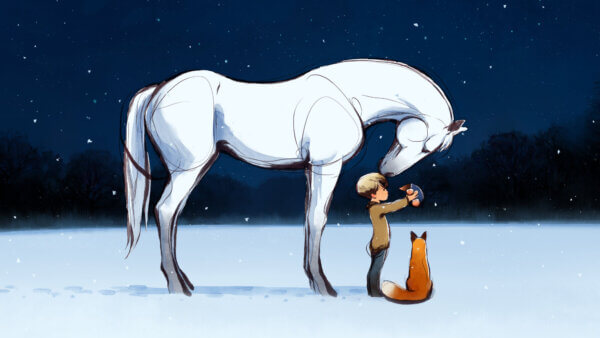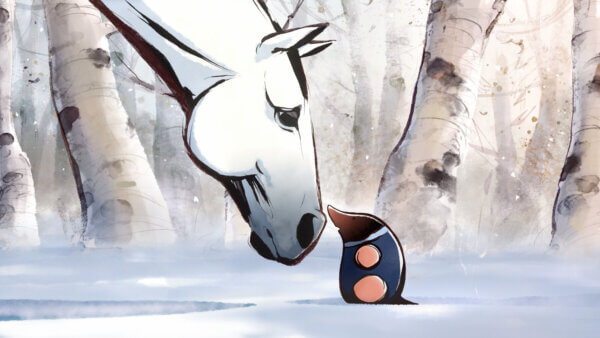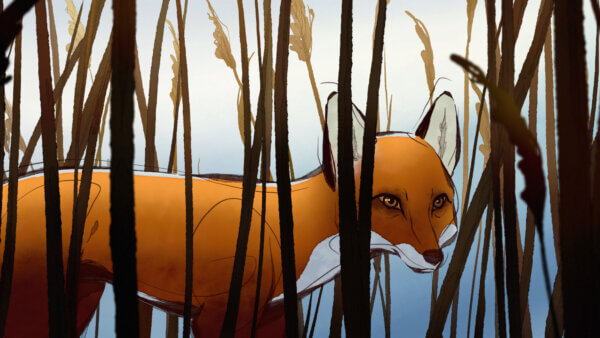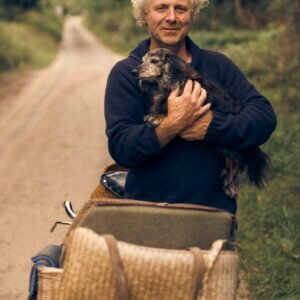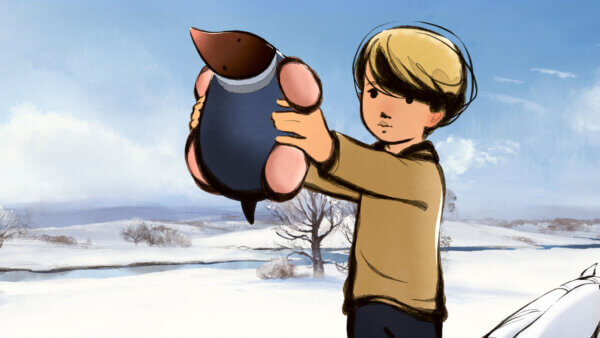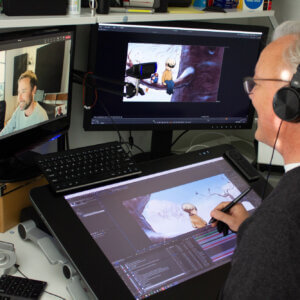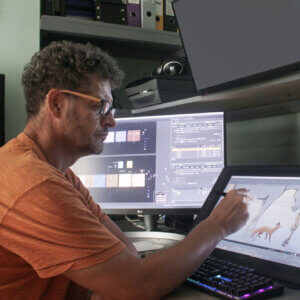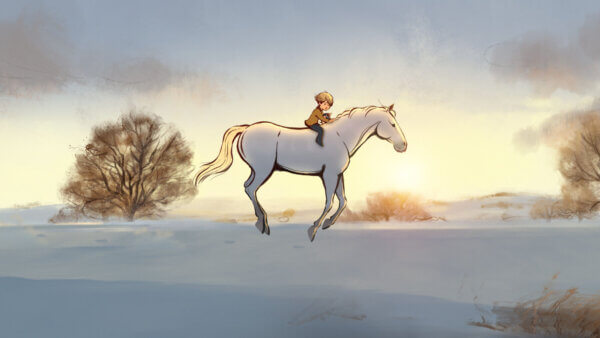Interview – The Boy, The Mole, The Fox and the Horse
When Charlie Mackesy’s internationally bestselling illustrated book ‘The Boy, the Mole, the Fox and the Horse’ was released it soon became an international bestseller, spending 100 weeks on the Sunday Times Bestsellers List.
The book was devised after author & illustrator Mackesy began filling his instagram account with feel good drawings that promoted, peace, empathy and introspection. The world has undergone a fair amount of emotional turbulence in previous years so it is clear to see why a book that promotes hope and compassion would strike a chord with readers worldwide.
Among the millions of readers was producer Cara Speller, the Oscar nominated producer behind Pear Cider & Cigarettes. After convincing the author that the book would be in safe hands with the seasoned producer viewers will now get the chance to experience the message of the tome in animated form through the lens of Mackesy, who finds himself in the directors chair for the first time with co-director Peter Baynton. Baynton is no stranger to animating kind characters and turning well loved books into treasured tv adaptations having storyboarded the brilliant Sarah & Duck, supervised story for Paddington 2 and directed animation on Lupus Films’ The Tiger Who Came to Tea.
Starring Tom Hollander, Idris Elba, Gabriel Byrne and newcomer Jude Coward Nicoll, the short has all the right ingredients to joining the pantheon of classic Christmas short films of a timeless quality that can be rewatched by generations. The Boy, The Mole, The Fox and the Horse is available in the UK on Christmas Eve on the BBC and iPlayer and then worldwide from the 25th December on Apple TV+. We caught up with Charlie Mackesy, Peter Baynton and Cara Speller.
Like the book, the film focuses on overt kindness and empathy, it seems important that these messages are heard in the world we live in now in books and on screen.
Charlie Mackesy – I think you’re right. We’ve had we’ve had different forms of hardness, you know, whether it’s pandemic and isolation or whether it’s economic I think everyone’s just feeling exhausted. It seems to me that if we’ve ever needed kindness, we need it now. And I don’t think there’s any human on Earth who couldn’t use a bit more kindness or comfort or hope or a healing. It was lovely to read from people’s messages during the pandemic about the book and I hope that film can do something similar in this time.
Did the themes of the book make it an easy choice for you to jump on board as a producer Cara?
Cara Speller – Yes, absolutely. I was initially drawn in just by the beauty of Charlie’s artwork and wanting to see that moving but then of course, you know the the messages and themes within it have kindness and gentleness and a messages about allowing yourself to be vulnerable and the power of friendship which are all things that we all value and that we all need a bit more of and the chance to to make something like that and put something like that out into the world is is a wonderful thing
Peter, you’re no stranger to directing stories with compassion and warmth to them, did the story attract you in a similar way.
Peter Baynton – Absolutely. It has heart you know, there’s so much heart in the characters and in the in the story which comes from the drawings in the book. That’s what gets me you know. Yeah, I love making things with heart, I guess. Yeah.
This is your first film as a Director Charlie, were there mindset challenges for you going from the page to the screen? There are moments in the book where the pages themselves play a role, such as The Mole interacting with a tea stain, these things are difficult to recreate on screen I imagine.
CM – It’s a great point. In the early days the tea stain was there and the idea of having a fourth wall was there. We wanted to somehow show the messiness of production. I was quite keen on having the odd blotch and the odd imperfection, but for an animator that’s a hard thing to hear. I think what the film does is it brings in a vulnerability of its own. In my introduction to the book I had to bring in a degree of honesty, and I think that was important for the book but in retrospect it wasn’t important for the film, because the film has its own fragility, its own vulnerability, its own imperfections within itself. This is my first book, I’ve illustrated a lot of books for other people and one of the things that always frustrated me was they never seemed to be quite honest enough, they were never quite messy enough. And I always wanted to make a book that was honest at the outset.
(In the film), there were so many ideas that we were ruminating over to try to see if we could, bring a bit of our own fragility into it. But then, in essence, that would have been the wrong thing, because it would have detracted from the very characters themselves and we wanted to bring their world in immediately, rather than show ours, so all that vulnerability and connection we wanted to sort of inculcate into the film itself, rather than arrogantly show that we were making it in some way. We wanted them people to enter their existence straightaway without any suggestion that anything existed beyond it. So that was our sort of trajectory, let’s not have anything like tea stains let’s just have their world existing in its own right.
PB – I think there was a point where we were searching for lots of blotches and things that would feel like they spoke to those moments in the book. But we realised there was almost a sort of disingenuous quality to adding stuff that would say, this is a messy process. Whereas you know, so it didn’t feel honest I guess.
Being a producer is not just looking at spreadsheets, it’s making sure that directors are happy, and that everyone’s able to tell the story that they want to tell. How did you facilitate these conversations and ensure that the story fed through properly?
CS – It was a very creatively collaborative process, I’m delighted to say. We had a small team of incredibly involved people in various departments and we would have at meetings. We would start the day with our daily reviews every morning, with everyone on Zoom and we would we, as a team thrash out these creative issues when they arose. And that’s why I think that everything, when you watch it, feels like those things have been creatively resolved.
- Lead Compositor Johnny Still working on “The Boy, the Mole, the Fox and the Horse,”
- Art Director Mike McCain working on “The Boy, the Mole, the Fox and the Horse,”
- Lead Compositor Nick Herbert working on “The Boy, the Mole, the Fox and the Horse,”.
I put that down to, to just how collaborative that process was, because everything was debated and there was no tiny detail that wasn’t actively discussed and argued one way or another until we found a resolution that felt true to the group. It was a really beautiful way of working actually.
There are moments in the book which cannot be translated into animation. A moment in this film is when the boy falls off the horse, and there’s an obvious effort to create that with step by step illustrated motion. Was there thinking here to stay loyal to the book?
PB – From the very start project we’re trying to honour not just the feel of the book and the spirit of the book, but also specific moments through storyboarding. We’re trying to match the way Charlie draws, the way he composes the characters in relation to each other and so all of that stuff that goes into the storyboarding. It is informed by a desire to do an adaptation of the book that feels true to its spirits and also its look. There are emblematic images from the book, like when you see the boy and the mole sitting on the branch from behind, where we just knew we needed to have that moment in it.
I think it’s a pastel or a charcoal moment in the book where the horse comes down into the water, and it’s a backlit image and the horse says, “you fell, but I got you.” So then moments where visually we wanted to hit, I hit them. And I think that moment when they jumped over the ditch was one of them. There’s just a series of very powerful images that Charlie drew in the book that we wanted to hit. It came about actually, through Daniel, our editor just cut the storyboard drawings that way and created this moment of heightened drama and it lived on like that all the way through the project. And then at some point Cara I think had this wonderful idea that Charlie could actually ink the drawings for that moment.
The film is released at Christmas but has no ‘jingle bells’ or Santa Claus in it. How do you ensure that a film is for everyone, for the ages and timeless? What are the magical ingredients?
CS – I think having Charlie Mackesy involved is probably the first magic ingredient that you need!
CM – It’s not how it looks. It’s what the messages are. And I think the messages are about being human. And I think that there are issues that we’ve struggled with for thousands of years that we’re the same, the human condition is the same and I think always will be. It’s dealing with whatever we have, like fear or disconnection, or, or hope or a sense of isolation or being lost, or all the things I think all of us go through – the things it tries to connect with and raise it within the conversation. And I suppose in that respect, it’s timeless, because you know, they were talking about this and Roman times, and they’ll be talking about this until, you know, something terrible happens to the planet. But yeah, so that’s my answer. Even if it looks like it was made a long time ago, I think the issues discussed will always be the same, don’t you?
PB – I think for me, there’s a gentleness and warmth, watching it, and that I think makes it. I mean, I know now watched it hundreds of times, and I have to admit I do enjoy it. Normally I don’t enjoy my work for a long time, but you know, I think there’s a way it deals with drama I feel very proud, like proud of and sort of, you know, I think is particular to it that, you know, there were there were moments when we were when the script is being written and we were developing the storyboard where there were bigger, dramatic options and avenues to explore and I think there’s something about just holding back on that slightly and just keeping some of this quiet. It’s quite a warm journey, I don’t know if that gives a timeless quality of what but I for me it’s something that’s gives it its character that makes me want to watch it on repeat rather than see it once, feel something and not bother again.
The Boy, The Mole, The Fox and the Horse is available in the UK on Christmas Eve on the BBC and iPlayer and then worldwide from the 25th December on Apple TV+.


